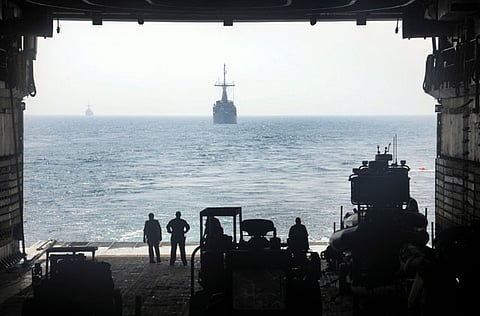US leads biggest Gulf mine-clearing exercise
Biggest Gulf operation of its kind designed to act as warning to Iran, signal to Israel

Manama: The US and 29 other nations have begun the biggest mine-clearing exercise in the Gulf region, a show of force as tensions escalate over a threatened Israeli attack on Iran’s nuclear facilities.
The 12-day exercise that started on Sunday involves Western nations such as the UK and France, as well as participants as varied as Japan, Yemen, Jordan, New Zealand and Estonia, according to the US Navy. In an effort to avoid a showdown with the Islamic Republic, it won’t extend into the Strait of Hormuz, the waterway between Iran and Oman through which as much as a fifth of the world’s traded oil is shipped daily.
In addition to serving as a warning to Iran, the display of power will “signal to Israel that the United States has a military option available” and show “US resolve to its Persian [Arabian] Gulf allies, especially in the face of repeated Iranian threats to try to close the Strait of Hormuz,” according to Kenneth Katzman, a Middle East specialist for the nonpartisan Congressional Research Service in Washington.
Participating nations will conduct mine-hunting and mine-countermeasure operations with MH-53E Sea Dragon helicopters, as well as explosive ordnance disposal, diving and small-boat exercises and port-clearance operations focused on underwater improvised explosive devices, according to the US Navy 5th Fleet, which is headquartered in Bahrain.
The exercise will focus “on a hypothetical threat to mine the international strategic waterways of the Middle East, including the Red Sea, the Gulf of Aden, the Gulf of Oman, and the Persian [Arabian] Gulf,” said the US Central Command in Tampa, Florida in a statement.
Iranian officials have periodically threatened to close the strait, which is 34 kilometres wide at its narrowest point, in retaliation for tightening international sanctions aimed at dissuading them from developing a nuclear weapon. Laying mines or sinking a ship in the strait would disrupt tanker traffic and also prompt insurance companies to raise rates on tankers, leading, at least temporarily, to higher oil prices.
Iran’s Revolutionary Guard Corps is ready to fight a possible military offensive and “nothing will remain” of the Israeli government if it attacks, said Major General Mohammad Ali Jafari, commander-in-chief of the corps, according to the official Islamic Republic News Agency.
Israeli Prime Minister Benjamin Netanyahu and Defence Minister Ehud Barak have said Israel may have no choice but to launch a strike against Iran’s nuclear facilities as international negotiations stall over the program.
Iran’s effort to develop nuclear weapons is now in a “red zone”, and the US must set a clear “red line” that Iran can’t cross without risking a military attack, Netanyahu said on Sunday on the NBC News program “Meet The Press”.
Netanyahu has become more vocal in demanding that the US define clear limits since Secretary of State Hillary Clinton said in a Bloomberg Radio interview on September 9 that the US is “not setting deadlines” on negotiations with Iran.
In addition to the mine-sweeping exercise, the US has two aircraft carrier strike groups in the region, with the USS Enterprise in the Arabian Sea and the USS Dwight D. Eisenhower in the Arabian Gulf.
The carriers’ presence tells Iran the US “can easily project devastating power on to Iranian soil at a moment’s notice,” Katzman said in an e-mail.
Defence Secretary Leon Panetta told CBS’s “This Morning” on September 11 that “we have the forces in place to be able to not only defend ourselves but to do what we have to do to try to stop them from developing a nuclear weapon.” Iran says its nuclear programme is for civilian purposes.
The mine-clearing exercise’s multi-national participation shows “we are not alone - it’s just not the United States ‘bullying’ Iran,” said Michael Eisenstadt, director of military studies at the Washington Institute for Near East Policy.
The exercise signals resolve among many countries that “if you try to disrupt freedom of navigation, we have the capability in place to, within a few days to a few weeks, resolve that and you’ll pay a heavy price,” Eisenstadt said.
Sign up for the Daily Briefing
Get the latest news and updates straight to your inbox



